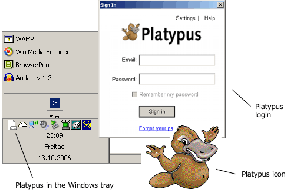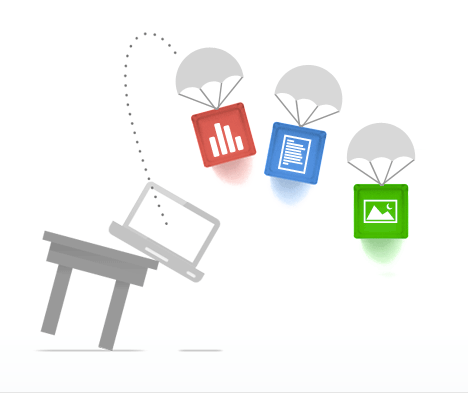Today’s launch of Google Drive, official at last, is kind of a relief. Internet rumors and reports have seen the industry discussing the possibility of a consumer-facing cloud storage service called “GDrive,” since as far back as 2006. Of course, then, the product in development was an internal-only tool used by Google employees – not the Dropbox-like competitor Google launched today.
Still, to say that we’ve been waiting for GDrive for a long, long, long time would be the understatement of the year.
For those of you with shorter memories, a trip down memory lane:
The first time we ever casually referred to something as “GDrive,” was when detailing an internal application that placed an icon on Googlers’ computers, giving them a mere 500 MB of storage. There was no evidence that the program was being prepared for public launch any time soon back then, despite user interest…not to mention obsessive blog coverage about the possibilities.
Back then, the cloud storage race was just beginning. Box was founded in 2005 and there were even reports that Microsoft would be launching its own GDrive-like service, code-named “Live Drive,” beating Google to the punch. As it turns out, Microsoft (with what we now know as SkyDrive) did beat Google to launch, as did many other cloud storage services, including notably, Box and Dropbox (founded 2007), both of which have been busy building successful businesses in the cloud storage and collaboration space.
Box.net CEO Aaron Levie even recently told TechCrunch TV, how his company is not afraid of Google Drive. Without discrediting the service – after all, Google is a big name – Levie said his company believes enterprise customers are looking to platform-agnostic players these days to help them manage information at scale, and especially to those focused exclusively on business and enterprise security needs.
Google had the opportunity to take the lead in the cloud storage space, but passed. Several months before Dropbox raised its $7.2 million A round in late 2009, consumers were still clamoring for a cloud dropbox of sorts from Google. A TechCrunch poll in 2008, had some 77% of respondents voting, “yes, I’ve been waiting like forever!” when asked if they would use GDrive.
And yet, no GDrive ever appeared.
By 2010, the world had practically given up on an “official” GDrive product. When Google added the ability to upload any file type to Google Docs, that was enough for Mike Arrington to proclaim “GDrive Launches” – after all, if you could put any file in the cloud, isn’t that GDrive enough for you?
But Google wasn’t having it. “This is not GDrive,” Google Docs product manager Vijay Bangaru told Arrington at the time. When asked why not, he replied, “…because GDrive doesn’t exist.”
Party-pooper.
Meanwhile, other startups came in to the fill the void left by our drag-and-drop to the cloud needs. Besides early players Box and Dropbox, one company, Memeo even went so far as to name its virtual drive feature “GDrive” back in 2010, if you can believe it.
Then for awhile, all was quiet on the GDrive front. It wasn’t until mid-2011 that GDrive’s rebirth really made the news once again. The internal project from 2006 (code-named “Platypus”) had been killed off back in 2008 – it never became a public-facing service. The concept for a Google-backed cloud service remained, however.
In August 2011, the URL drive.google.com appeared in Chromium code reviews. It’s alive!, the blogosphere proclaimed. And in September, more language was discovered inside Google Docs, pointing to Google Drive.
It was coming. For real this time.
 The new version was said to be nothing like the wonky Platypus, but more of a way to enhance Google Docs. The hope? That users would finally get it: Docs can, indeed, host more than Office-type files (i.e., word documents, spreadsheets, presentations). More importantly, it would allow for syncing files between your PC and mobile devices and cloud.
The new version was said to be nothing like the wonky Platypus, but more of a way to enhance Google Docs. The hope? That users would finally get it: Docs can, indeed, host more than Office-type files (i.e., word documents, spreadsheets, presentations). More importantly, it would allow for syncing files between your PC and mobile devices and cloud.
And now here it is, April 2012, and Google has finally gotten around to revealing GDrive. But does anyone still care? Users who really needed such a service have since migrated elsewhere. When Dropbox raised its $250M Series B in October, it was boasting over 45 million users. Now it has over 50 million. Box.net, meanwhile, raised $50M in September, touting 7 million users. Today, that’s 10 million.
Google says there are 40 million Google Apps users, including 4 million businesses, to give you an idea of the size of Google’s customer base.
Today’s Google Drive is GDocs+ – it has OCR, it has an API for apps! – but it’s no longer tapping into the pent-up, unsatisfied demand for a decent cloud storage and sync service. People who use Google Docs might try it, but if they’re already satisfied with the alternatives – the platform-agnostic, popular alternatives – they may just skip it.
After six years of waiting, though, some of us have to take a quick peek.
